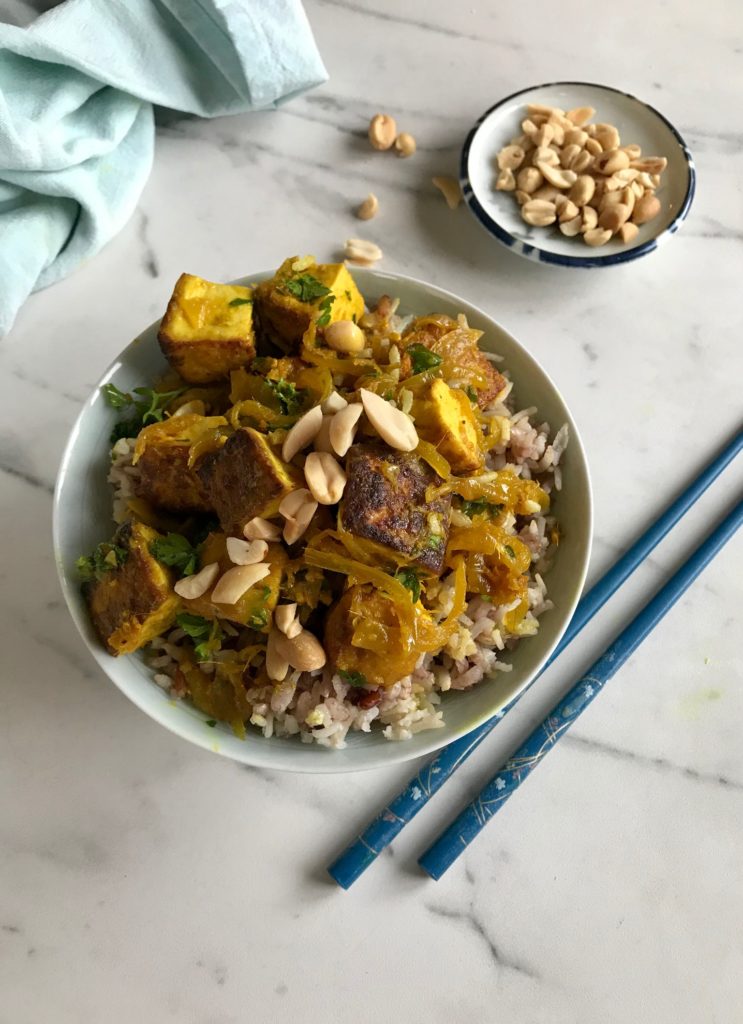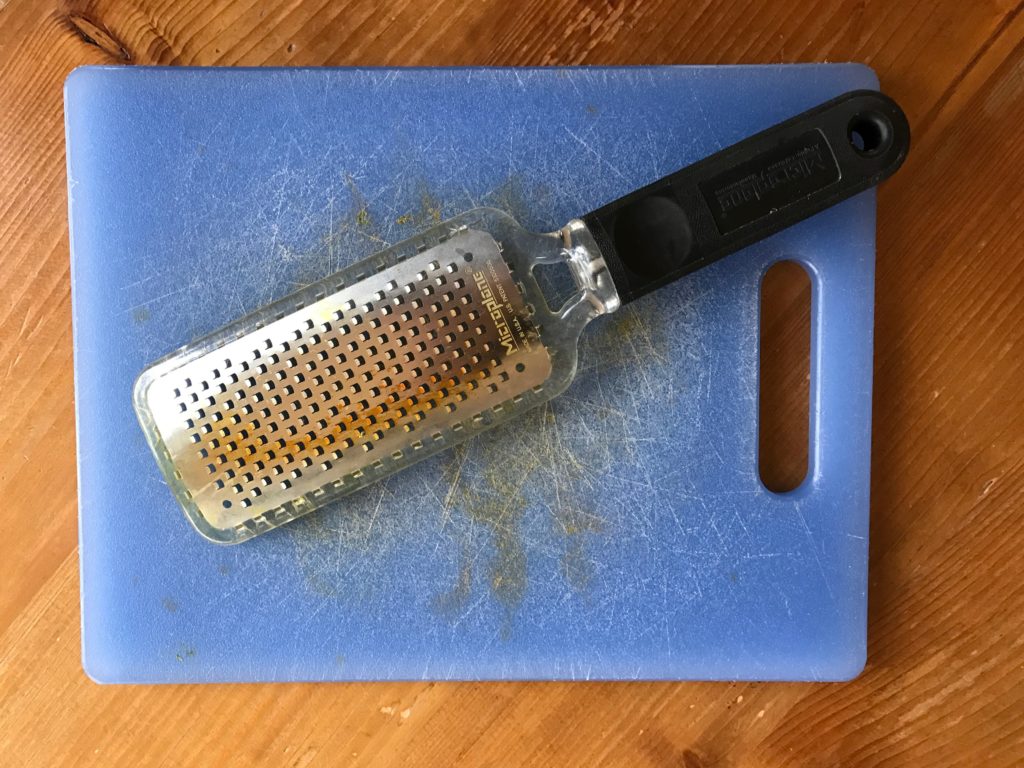Soy Food Myths

One of the hottest food trends is “plant-based” eating (1). A whopping 70% of Americans view plant proteins as more healthful than animal proteins (2).
To be clear, plant-based does not necessarily mean eating strictly plants, being vegan or vegetarian. Some plant-based eaters include seafood, meat and/or dairy in their diets.
One of my favorite plant-based proteins is tofu – and this Vietnamese-Inspired Turmeric Tofu is a recipe I keep coming back to.
If you’re concerned about protein quality, rest assured that soybeans are super-legumes, containing all the essential amino acids needed to build muscle – like meat and dairy (3). In other words, unlike other legumes, you don’t have to combine soy with a grain, nut or seed to get a complete amino acid profile. It’s economical, keeps well (check expiry dates and keep chilled if unless using a shelf-stable form) and is highly versatile.

Tofu welcomes any flavors. This recipe uses trendy turmeric and lemongrass. Far from a fad, turmeric has been used in cooking and medicine for thousands of years. Benefits come from the anti-inflammatory and antioxidant, anti-cancer, anti-mutagenic properties of the active ingredient curcumin (4).

I spark the dish with black pepper along with the traditional Thai bird chili because the piperine in black pepper can increase the bioavailability of curcumin up to 2000% (4). Adjust amounts of these ingredients to your taste.
As much as I love citrusy lemongrass, I hate mincing the woody stalks to release the flavor. My workaround is to whirl pieces in the blender with water. Instead of tossing the tops of the stalks, trim off the outer layer and simmer with water for a tea that may have calming benefits (5).
How could I post a soy recipe in October, Breast Cancer Awareness Month? It is a perfect time to clear up confusion around soy foods. A recent systematic review and meta-analysis of studies looked at soy, soy isoflavones and protein intake and mortality from all causes, cancer and cardiovascular diseases (6). Positive findings include:
- Soy/soy products consumption was inversely associated with deaths from cancers
- Soy protein intake was associated with a decreased risk in the mortality of breast cancer
A grand summary statement: “Our findings may support the current recommendation to increase intake of soy for greater longevity.”
Other experts agree. The American Institute for Cancer Research states (7) “eating a moderate amount of soy foods does not increase risk of breast cancer — or other types of cancer. A moderate amount is one to two servings a day of whole-soy foods.” Soy foods include soymilk, soybeans or edamame, tofu and tempeh.
Soy dietary supplements, soy pills and isoflavone-enriched powders should be avoided, as oncology dietitian Suzanne Dixon wisely recommends (8).
More on Isoflavones: Soy Isoflavone nutrients are phytoestrogens, structurally similar to the estrogen in women’s bodies, but not estrogen. We need more research on how they act in humans as shown in the research mentioned above (6) where three studies looked at soy isoflavone intake and breast cancer mortality related to estrogen receptor status. Soy isoflavones intake was beneficial in estrogen-negative breast cancer but not estrogen-positive breast cancer.
Read about more soy myths, such as isoflavones causing feminization in men in a Today’s Dietitian article (9).
If you like tofu or other soy foods, don’t hesitate to enjoy them.
Vietnamese-Style Turmeric Tofu Adapted from Pleasures of the Vietnamese Table by Mai Phan.
Fresh knobs of turmeric, a relative of ginger, have become staples in most grocery stores. Peel and grate it to use in recipes – or use dry turmeric. Sometimes I use both! Adjust the amounts of black pepper and fiery Thai bird chili to your taste. Use refrigerated, water-packed tofu in this recipe.
Serves 4
4 tablespoons peanut, avocado or other vegetable oil, divided
2 packages (1 lb. each) firm tofu, drained and cut into ¾-inch cubes
4 stalks lemongrass, bottom 3-4 inches, trimmed of tough outer leaves and cut into 1/3-inch pieces to measure 1/2 cup
1 cup water
¼ to 1 Thai bird chili, finely chopped or 1/4 to 1 teaspoon red pepper flakes
2 ½ tablespoons grated, peeled fresh turmeric or 2 teaspoons ground dry turmeric
4 teaspoons granulated sugar
1 tablespoon soy sauce
1 ½ teaspoons kosher salt, divided
¼ teaspoon ground black pepper, more or less to taste
4 shallots, peeled and thinly sliced
1 yellow onion, thinly sliced (1/8 inch)
2 cloves garlic, minced
1 cup Thai basil leaves, cilantro, mint, parsley or a combination
Chopped, roasted peanuts
Cooked rice, brown or black preferred
- In a large, deep non-stick skillet, heat 2 tablespoons oil over medium- to medium-high heat. Add tofu cubes and cook, stirring a couple of times, for 15 to 20 minutes or until golden brown and crispy.
- While tofu browns, in blender container combine lemongrass, chili, and 1 cup water. Whirl until lemongrass is finely chopped. Pour into a bowl. Stir in turmeric, sugar, soy sauce, ¾ teaspoon salt and black pepper.
- Remove browned tofu from skillet to bowl. Stir in lemongrass mixture. Return unwashed skillet to stove. Add remaining 2 tablespoons oil and place over medium to medium-high heat. Add shallots, onion and garlic. Sprinkle with ¾ teaspoon salt. Cover and cook for 2 minutes, stirring once, until onion and shallot begin to release some liquid. Uncover and cook, stirring often, until golden brown. Stir in tofu-lemongrass mixture. Cover, adjust heat and simmer gently for 8-10 minutes. Uncover and stir well. If sauce is watery, continue to simmer until reduced to a saucy consistency.
- Remove from heat. Taste and add additional salt, pepper or soy sauce if desired. Stir in basil.
- Serve warm, topped with peanuts. Accompany with rice.
References
- From CBD to plant based: 4 trends that dominated Expo West in 2019. Byington L. Accessed October 23, 20192
- International Food Information Council. 2018 Food and Health Survey. https://foodinsight.org/2018-food-and-health-survey/ Accessed October 23, 20193
- Protein – Which is Best? Jay R. Hoffman and Michael J. Falvo J Sports Sci Med. 2004 Sep; 3(3): 118–130. Sep 1, 2004.4
- Curcumin: A Review of Its’ Effects on Human Health. Susan J. Hewlings and Douglas S. Kalman Foods. 2017 Oct; 6(10): 92. Published online 2017 Oct 22, 2017. 5
- What are the health benefits of lemongrass tea? Last updated Wed 24 October 24, 2018. By Rachel Nall, RN, BSN, CCRN Reviewed by Debra Rose Wilson, PhD, MSN, RN, IBCLC, AHN-BC, CHT 6
- Soy, Soy Isoflavones, and Protein Intake in Relation to Mortality from All Causes, Cancers, and Cardiovascular Diseases: A Systematic Review and Dose–Response Meta-Analysis of Prospective Cohort Studies. Journal of the Academy of Nutrition and Dietetics. September 2019. Volume 119, issue 9 pp 1483-1500. Seyed Mostafa Nachvak, PhD, Shima Moradi, MSc, Javad Anjom-shoae, MSc, Jamal Rahmani, MSc, Morteza Nasiri, MSc, Vahid Maleki, MSc, Omid Sadeghi, MSc.7
- AICR’S Foods That Fight Cancer™ Soy 7
- Soy and Breast Cancer. Suzanne Dixon, MPH, MS, RD. Oncology Nutrition, a dietetic practice group of the Academy of Nutrition and Dietetics
- The Top 5 Soy Myths. Judith C. Thalheimer, RD, LDN,Today’s Dietitian. Vol. 16 No. 4 P. 52 April 2014.
© Lorelle Del Matto 2019
 About lorelle
About lorelle
Speak Your Mind